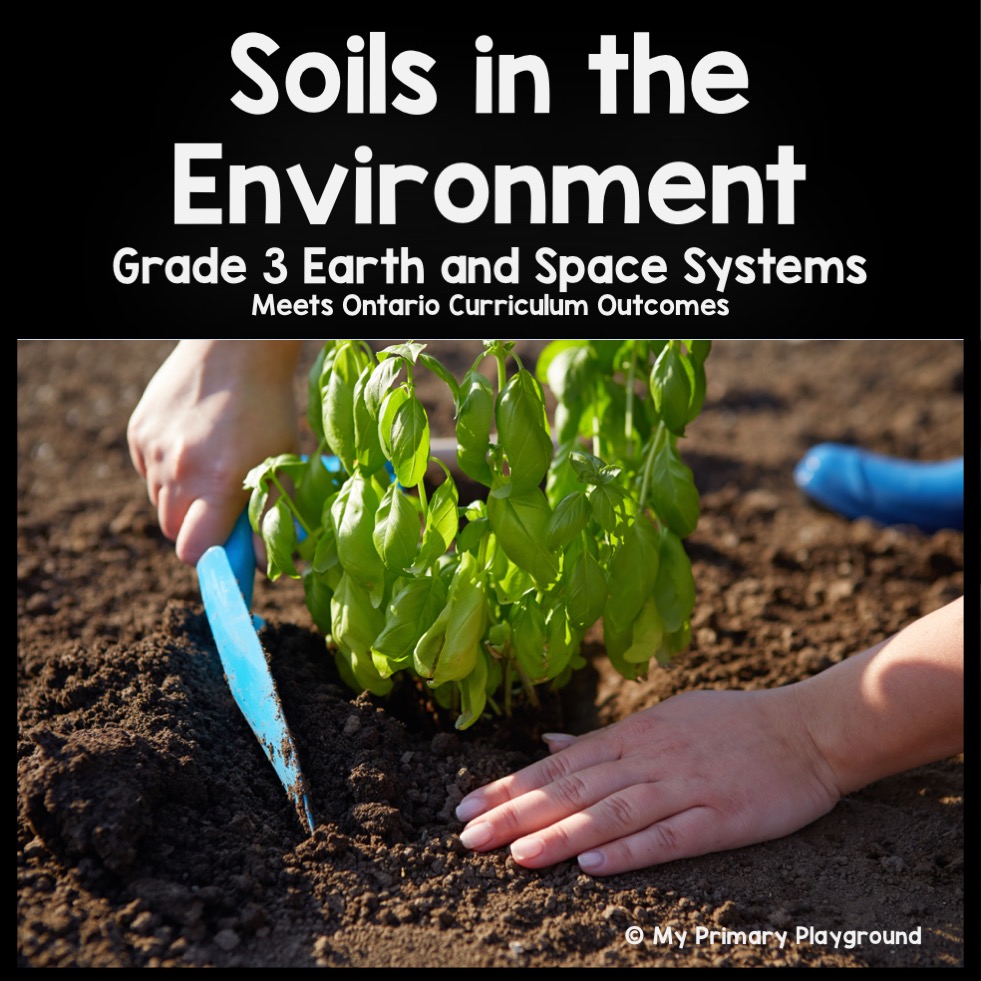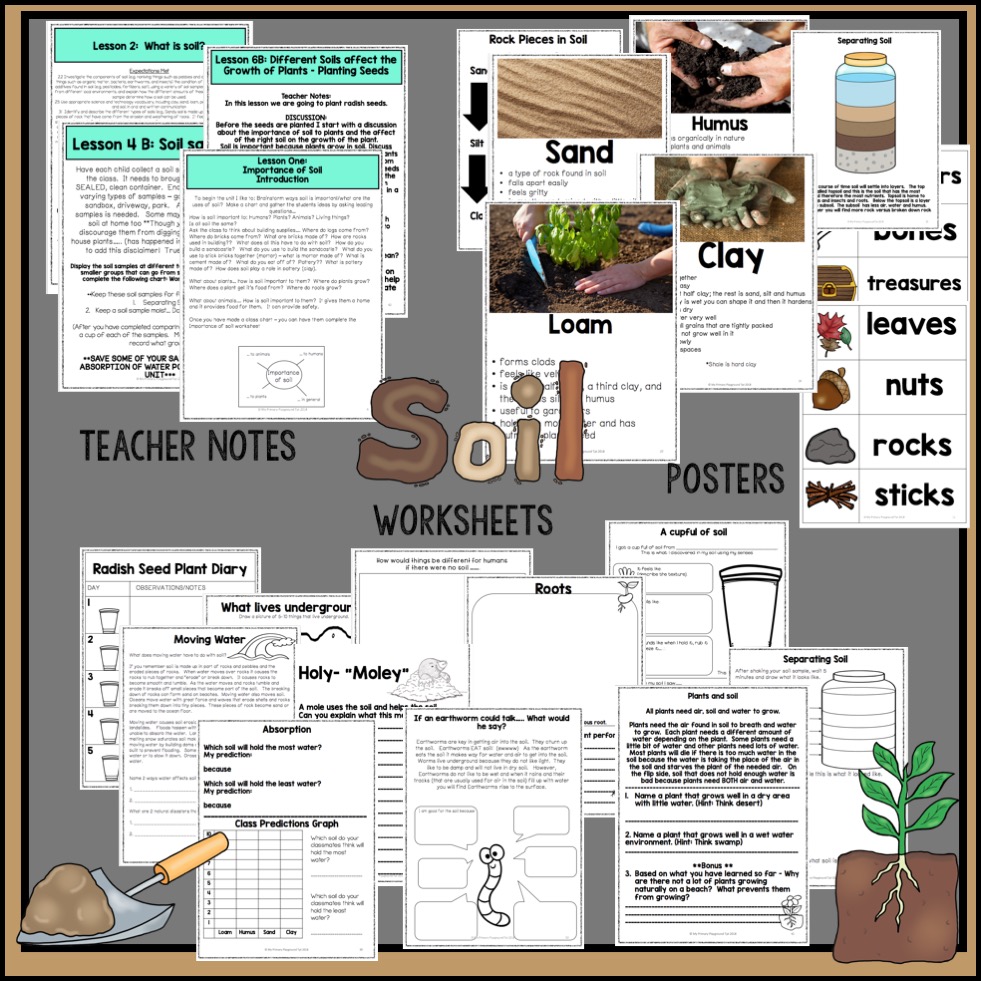Description
Do you want a fun and engaging, hands-on science unit that will cover your curriculum expectations for grade 3 Earth and space systems: Soils in the environment? This unit is for you!
Lesson plans are provided for every lesson and any materials needed are listed so you can gather them in advance of the lesson.
Bright colorful posters help students understand the terminology and are great for posting as reference material on your science bulletin board!
Key concepts covered:
- The importance of soil
- Exploring soil
- What is soil made of?
- Different types of soil
- Soil samples
- Separating soil
- The absorption of water into soil
- Plants and soil
- The effect soil has on plants
- Roots
- What or who lives in soil?
- Erosion
- Compost
- Building with Soil – both animals and humans
Outcomes covered:
Overall:
1.0 Assess the impact of soils on society and the environment, and of society and the environment on soils
2.0 Investigate the composition and characteristics of different soils
3.0 Demonstrate an understanding of the composition of soils, the types of soils, and the relationship between soils and other living things
Specific:
1.1 Assess the impact of soils on society and the environment and suggest ways in which humans can enhance positive effects and/or lessen or prevent harmful effects
1.2 Assess the impact of human activity on soils and suggest ways in which humans can affect soils positively and/or lessen or prevent harmful effects on soils
2.1 Follow established safety procedures during science and technology investigations (e.g. wash hands after working with soil samples)
2.2 Investigate the components of soil (e.g. nonliving things such as pebbles and decaying matter; living things such as organic matter, bacteria, earthworms, and insects) the condition of soil (e.g. wet, dry) and additives found in soil (e.g. pesticides, fertilizers, salt), using a variety of soil samples (e.g., sand, clay, loam) from different local environments, and explain how the different amounts of these components in a soil sample determine how a soil can be used.
2.3 Use scientific inquiry/experimentation skills, and knowledge and skills acquired from previous investigations, to determine which type (s) of soil (e.g., sandy soil, clay soil, loam) will sustain life
2.4 Investigate the process of composting and explain some advantages and disadvantages of compost (e.g., set up a pop-bottle composter in the classroom, and observe what happens over time
2.5 Use appropriate science and technology vocabulary, including clay, sand, loam, pebbles, earth materials, and soil, in oral and written communication
2.6 Use a variety of forms (e.g., oral, written, graphic, multimedia) to communicate with different audiences and for a variety of purposes (e.g., record in words and pictures what happens when soil and water are shaken together in a container, prepare a display comparing the composition of soils from different locations)
3.1 Identify and describe the different types of soils (e.g., Sandy soil is made up of minerals and tiny pieces of rock that have come from the erosion and weathering of rocks. It feels gritty and does not stick together well. Sandy soil drains easily and quickly after a rain and warms up quickly in the spring, but does not hold water and nutrients as well as clay soil and is eroded more easily. Loamy soil is made up of sand, silt and clay in relatively equal amounts. It sticks together better than sand but not as well as clay. Loamy soil holds water and nutrients well, and also drains well so that sufficient air can reach the roots. Clay soil is a very fine-grained soil that is plastic when wet but hard when dried. It feels slick and smooth. Clay soils have poor drainage and aeration.)
3.2 Identify additives that might be in soil but that cannot always be seen (e.g., pesticides, fertilizers, salt)
3.3 Describe the interdependence between the living and nonliving things that make up soil (e.g., earthworms ingest the soil and absorb the nutrients, then their castings return the nutrients to the soil; the roots of plants use the soil as an anchor to keep the plants from blowing away.
3.4 Describe ways in which the components of various soils enable the soil to provide shelter/homes and/or nutrients for different kinds of living things (e.g., microscopic bacteria and microorganisms feed on decaying matter in the soil; roots of plants absorb minerals from the soil)
Please check out my preview and feel free to email me if you would like more information!
Terms
Copyright © Laura Merritt – Stop and Smell the Crayons (Tpt) All rights reserved by the author. This product is to be used by the original downloader only. Copying for more than one teacher, classroom, department, school, or school system is prohibited. This product may not be distributed or displayed digitally for public view. Failure to comply is a copyright infringement and a violation of the Digital Millennium Copyright Act (DMCA). Clipart and elements found in this PDF are copyrighted and cannot be extracted and used outside of this file without permission or license. Intended for classroom and personal use ONLY. See product file for clip-art and font credits.


Reviews
There are no reviews yet.